Cameo Communications WLB2203 IEEE 802.11lb WIRELESS LAN BROADBAND ROUTER User Manual WLB 2203 User s Manual
Cameo Communications Inc IEEE 802.11lb WIRELESS LAN BROADBAND ROUTER WLB 2203 User s Manual
USERS MANUAL
IEEE 802.11b
Wireless BroadBand Router
User Guide

i
Regulatory notes and statements
Wireless LAN, Health and Authorization for use
Radio frequency electromagnetic energy is emitted from Wireless LAN
devices. The energy levels of these emissions however are far much less than
the electromagnetic energy emissions from wireless devices like for example
mobile phones. Wireless LAN devices are safe for use frequency safety
standards and recommendations. The use of Wireless LAN devices may be
restricted in some situations or environments for example:
·On board of airplanes, or
·In an explosive environment, or
·In case the interference risk to other devices or services is perceived or
identified as harmful
In case the policy regarding the use of Wireless LAN devices in specific
organizations or environments (e.g. airports, hospitals, chemical/oil/gas
industrial plants, private buildings etc.) is not clear, please ask for
authorization to use these devices prior to operating the equipment.
Regulatory Information/disclaimers
Installation and use of this Wireless LAN device must be in strict accordance
with the instructions included in the user documentation provided with the
product. Any changes or modifications made to this device that are not
expressly approved by the manufacturer may void the user’s authority to
operate the equipment. The Manufacturer is not responsible for any radio or
television interference caused by unauthorized modification of this device, of
the substitution or attachment. Manufacturer and its authorized resellers or
distributors will assume no liability for any damage or violation of
government regulations arising from failing to comply with these guidelines.
USA-FCC (Federal Communications Commission) statement
This device complies with Part 15 of FCC Rules.
Operation is subject to the following two conditions:
1. This device may not cause interference, and

ii
2. This device must accept any interference, including interference that may
cause undesired operation of this device.
FCC Radio Frequency Exposure statement
This Wireless LAN radio device has been evaluated under FCC Bulletin OET
65 and found compliant to the requirements as set forth in CFR 47 Sections
2.1091, 2.1093, and 15.247 (b) (4) addressing RF Exposure from radio
frequency devices. The radiated output power of this Wireless LAN device is
far below the FCC radio frequency exposure limits. Nevertheless, this device
shall be used in such a manner that the potential for human contact during
normal operation is minimized.
When nearby persons has to be kept to ensure RF exposure compliance, in
order to comply with RF exposure limits established in the ANSI C95.1
standards, the distance between the antennas and the user should not be less
than 20 cm.
FCC Interference Statement
This equipment has been tested and found to comply with the limits for a
Class B digital device, pursuant to Part 15 of the FCC Rules. These limits are
designed to provide reasonable protection against harmful interference in a
residential installation.
This equipment generates, uses, and can radiate radio frequency energy. If not
installed and used in accordance with the instructions, it may cause harmful
interference to radio communications.
However, there is no guarantee that interference will not occur in a particular
installation. If this equipment does cause harmful interference to radio or
television reception, which can be determined by turning the equipment off
and on, the user is encouraged to try and correct the interference by one or
more of the following measures:
1. Reorient or relocate the receiving antenna.
2. Increase the distance between the equipment and the receiver.
3. Connect the equipment to an outlet on a circuit different from that to which
the receiver is connected.
4. Consult the dealer or an experienced radio/TV technician for help.

iii
Export restrictions
This product or software contains encryption code that may not be exported or
transferred from the US of Canada without an approved US Department of
Commerce export license.
Safety Information
Your device contains a low power transmitter. When device is transmitted it
sends out radio frequency (RF) signal.
CAUTION: To maintain compliance with FCC’s RF exposure guidelines, this
equipment should be installed and operated with minimum distance 20cm
between the radiator and your body. Use on the supplied antenna.
Unauthorized antenna, modification, or attachments could damage the
transmitter and may violate FCC regulations.
CE Mark Warning
This is a Class B product. In a domestic environment, this product
may cause radio interference, in which case the user may be required
to take adequate measures.
Protection requirements for health and safety – Article 3.1a
Testing for electric safety according to EN 60950 has been conducted.
These are considered relevant and sufficient.
Protection requirements for electromagnetic compatibility –
Article 3.1b
Testing for electromagnetic compatibility according to EN 301 489-1,
EN 301 489-17 and EN 55024 has been conducted. These are
considered relevant and sufficient.
Effective use of the radio spectrum – Article 3.2
Testing for radio test suites according to EN 300 328-2 has been
conducted. These are considered relevant and sufficient.

v
TABLE OF CONTENT
About This Guide...........................................................................................1
Purpose........................................................................................................1
Overview of this User’s Guide ................................................................1
Introduction.....................................................................................................3
Applications:...............................................................................................4
Features:......................................................................................................4
Unpacking and Setup.....................................................................................5
Unpacking ...................................................................................................5
Setup.............................................................................................................5
Hardware Installation ....................................................................................7
Front Panel..................................................................................................7
Rear Panel ...................................................................................................8
Hardware connections...............................................................................9
Connect the Router using LAN ..........................................................9
Connect the Router using Wireless LAN........................................10
Check the installation .........................................................................10
PC Network TCP/IP Setting.......................................................................11
Windows 95/98/ME................................................................................11
Windows 2000..........................................................................................13
Windows NT4.0.......................................................................................14
Windows XP.............................................................................................15
Wireless Broadband Router Configuration..............................................17
Login to the Wireless Broadband Router through WLAN...............17
Login to the Wireless Broadband Router through LAN...................17

vi
Using the Web Browser..........................................................................17
Quick Setup...............................................................................................18
Advance Setup..........................................................................................23
Technical Specifications.............................................................................39
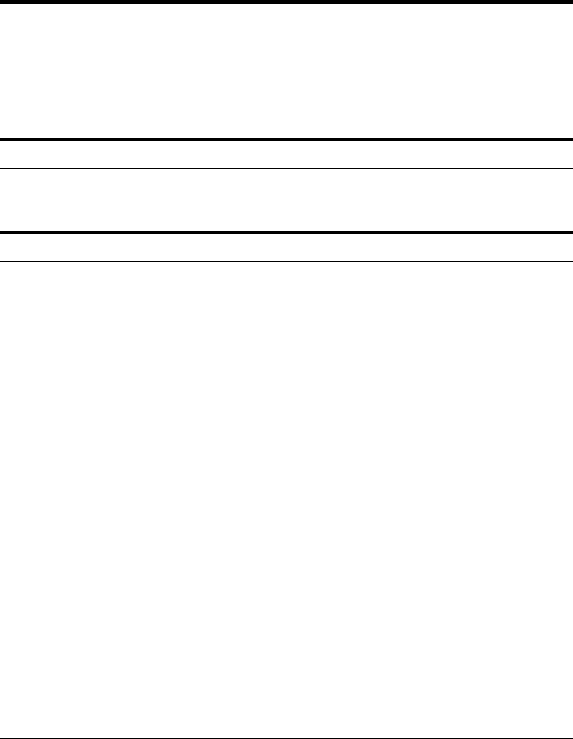
1
ABOUT THIS GUIDE
Congratulations on your purchase of this IEEE 802.11b Wireless
Broadband Router. This integrated access device combines Internet
gateway functions with wireless LAN and Fast Ethernet switch. It
provides a complete solution for Internet surfing and office resources
sharing, and it is easy to configure and operate for every users.
Purpose
This manual discusses how to install the IEEE 802.11b Wireless
Broadband Router.
Overview of this User’s Guide
Introduction. Describes the Wireless Broadband Router and its features.
Unpacking and Setup. Helps you get started with the basic installation of
the Wireless Router.
Identifying External Components. Describes the front panel, rear panel
and LED indicators of the Wireless Router.
Connecting the Router. Tells how you can connect the Wireless Router
to your xDSL/Cable Modem.
Technical Specifications. Lists the technical (general, physical and
environmental, performance and Routers settings) specifications of the
Wireless Broadband Router.

3
INTRODUCTION
With the explosive growth of the Internet, accessing information and
services at any time, day or night has become a standard requirement for
most people. The era of the standalone PC is waning. Netwo rking
technology is moving out of the exclusive domain of corporations and
into homes with at least two computers.
This integrated access device combines Internet gateway functions with
wireless LAN and Fast Ethernet switch. Designed for the business and
home, it saves you the cost of installing a separate modem and ISP line
for each computer, while providing ready connection for the users, with or
without the network wires.
Broadband network access is also gaining ground. However, allowing
more than two computers to access the Internet at the same time means
less affordable, higher costs. Thus, there is a need to share one legal IP
address over a single Internet connection to link the home with the
Internet.
The scarcity of IP addresses and using a shared Internet connection
through an Internet sharing device can solve high network access costs.
All linked computers can make full use of broadband capabilities over
such a device.
This device not only comes equipped with a wide range of features, but
also can be installed and configured right out of the box. This device
supports a simple local area network and Internet access share, offering
great cost savings.
The local area network connects up home computers while also allowing
any of the computers to access the Internet, share resources, or play online
games —the basis of the family computing lifestyle.

4
Applications:
Broadband Internet access:
Several computers can share one high-speed broadband connection
through wireless or wired (WLAN, LAN and WAN-Internet).
Resource sharing:
Share resources such as printers, scanners and other peripherals.
File sharing:
Exchange data, messages, and distribute files thus making good use of
hard disk space.
Online gaming:
Through the local area network, online gaming and e-commerce services
can be easily setup.
Firewall:
A built-in firewall function — for security and anti-hack system.
Features:
Ø High speed data transfer rate
Ø Supports NAT for share 1 IP address to all LAN user.
Ø Supports PPPoE and PPTP protocol for Dial-Up ADSL.
Ø Supports 64/128 bit WEP Encryption
Ø Supports DHCP Server / Client.
Ø Supports UPnP (Universal Plug and Play).
Ø Supports virtual server mapping.
Ø Supports packet filtering.
Ø Simple Firewall protection.
Ø Upgradeable firmware for future function.
Ø Simple setting using Quick Setup.
Ø Easy configuration via WEB Browser.
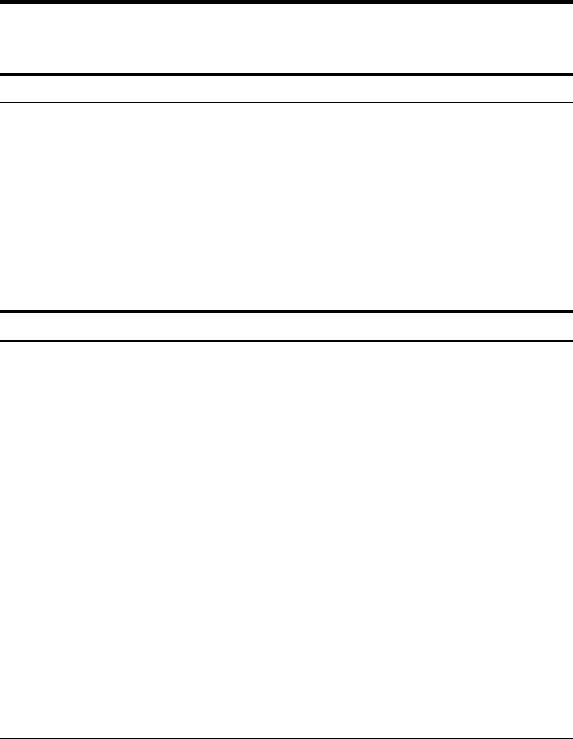
5
UNPACKING AND SETUP
This chapter provides unpacking and setup information for the Wireless
Broadband Router.
Unpacking
Open the box of the Wireless Broadband Router and carefully unpack it.
The box should contain the following items:
u One Wireless Internet Broadband Router
u One external power adapter
u One CD-Rom with this User’s Guide
If any item is found missing or damaged, please contact your local reseller
for replacement.
Setup
The setup of the Wireless Broadband Router can be performed properly
using the following methods:
u The power outlet should be within 1.82 meters (6 feet) of the
Broadband Router.
u Visually inspect the DC power jack and make sure that it is fully
secured to the power adapter.
u Make sure that there is proper heat dissipation from and adequate
ventilation around the Broadband Router. Do not place heavy
objects on the Broadband Router.
u Fix the direction of the antennas. Try to place the Wireless
Router in a position that can best cover your wireless network.
Normally, the higher you place the antenna, the better the
performance will be. The antenna’s position enhances the
receiving sensitivity.
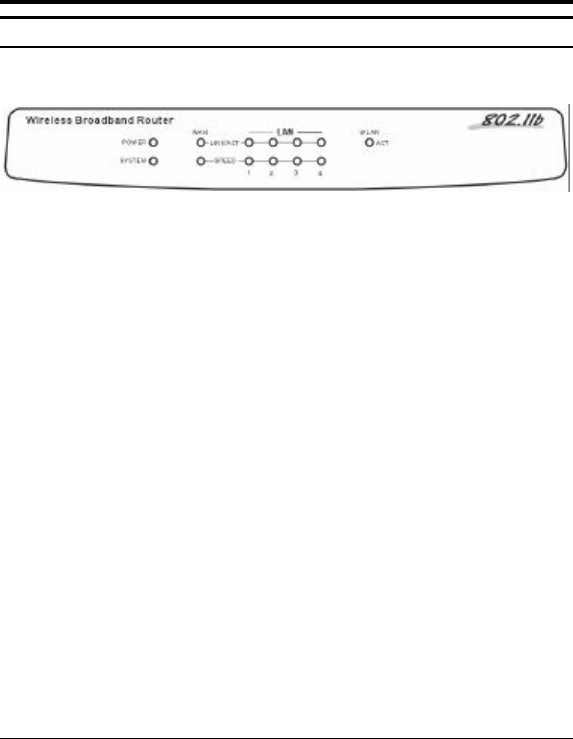
7
HARDWARE INSTALLATION
Front Panel
The figure below shows the front panel of the Wireless Broadband Router.
Wireless Broadband Router Front Panel
POWER
This indicator lights green when the hub is receives power, otherwise it is
off.
SYSTEM
This indicator blinks green means the Internet Broadband Router is
working successful. Otherwise, this indicator always on or off means the
function of the Internet Broadband Router is fail.
Link/ACT (WAN / LAN)
These indicators light green when the LAN/WAN port were connected to
an xDSL/Cable modem successfully.
These indicators blink green wh ile the LAN/WAN port were transmitting
or receiving data on the xDSL/Cable modem.
Speed (WAN / LAN)
These indicators lights green when these ports were connected to the
100Mbps Fast Ethernet Network, otherwise these indicators remains
off while the network were connected to 10Mbps Ethernet Network.
WLAN (ACT)
This indicator lights green when there are wireless devices connected and
transmitting data to the Wireless Router.
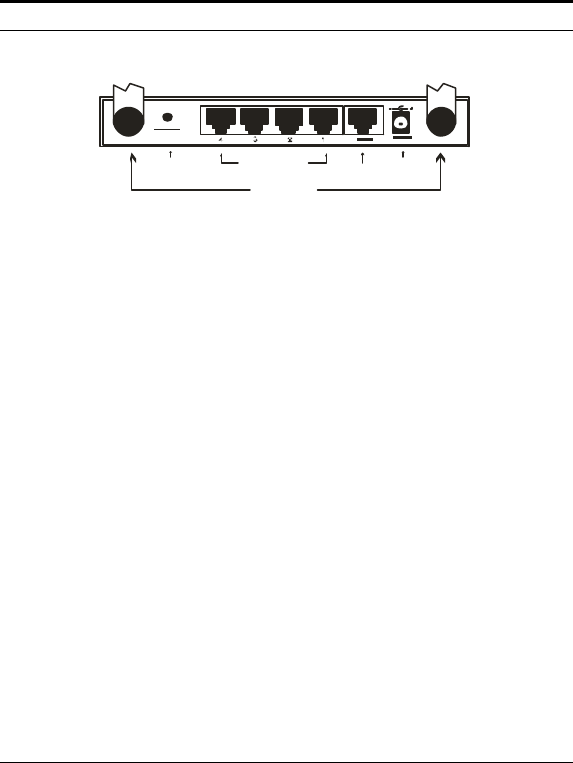
8
Rear Panel
The figure below shows the rear panel of the Wireless Broadband Router.
LAN Ports WAN Ports
Power JackReset
Antenna
Wireless Broadband Router Rear Panel
Antenna
There are two 2dBi Gain Antenna in the rear panel for wireless
connection.
DC IN
Plug the power adapter to this power jack
WAN
In the four port broadband router, there is an RJ-45 10/100Mbps Auto-
MDIX port for the WAN that will fit the xDSL/Cable modem’s
specification need.
LAN (1-4)
Four RJ-45 10/100Mbps Auto-MDIX ports for connecting to either
10Mbps or 100Mbps Ethernet connections.
RESET
Use a pin-shape item to push to reset this device to factory default settings.
It will be useful too when the manager forgot the password to login, but
the setting will be back to default setting.
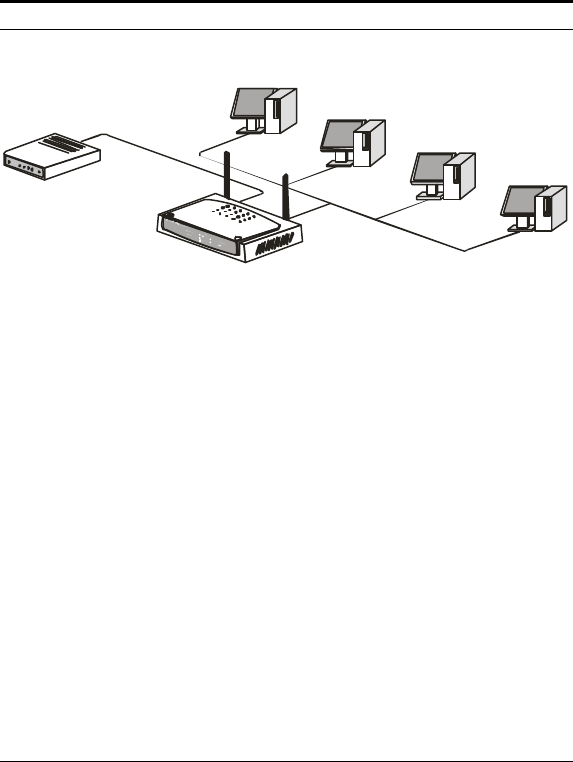
9
Hardware connections
Connect the Router using LAN
WirelessBroadband Router
PC
xDSL Modem PC
PC
PC
WAN port
LAN port
1. Plug in one end of the network cable to the WAN port of the
Wireless Internet Broadband Router.
2. Plug in the other end of the network cable to the Ethernet port of the
xDSL or Cable modem.
3. Use another network cable to connect to the Ethernet card on the
computer system, the other end of the cable connects to the LAN port
of the Internet Broadband Router. Since the Wireless Broadband
Router has four ports, you can connect up to four computers directly
to the unit. There you do not have to buy a switch to connect these
computers since one Internet Broadband Router functions both as a
connection-sharing unit and as a switch.
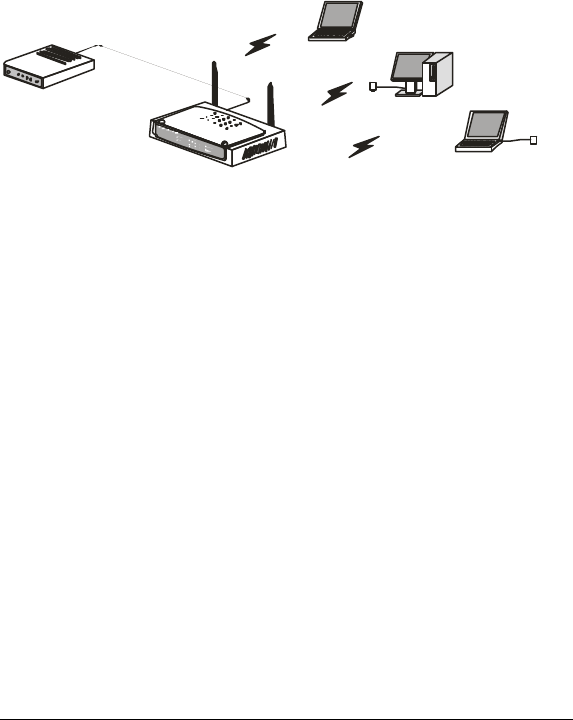
10
Connect the Router using Wireless LAN
PC
Notebook
Notebook
Wireless LAN Networking
WirelessBroadband Router
xDSL Modem
WAN port
1. Plug in one end of the RJ45 network cable to the xDSL/Cable
Modem.
2. Plug in the other end of the RJ45 network cable to the Wireless
Internet Broadband Router WAN port.
Check the installation
The control LEDs of the Wireless Internet Broadband Router are clearly
visible and the status of the network link can be seen instantly:
1. With the power source on, once the device is connected to the
broadband modem, the Power, CPU, LAN, WLAN and WAN port
link LEDs of the Internet Broadband Router will light up indicating a
normal status.
2. While the WAN is link up to the ADSL/Cable modem, the WAN
port ’s Link/ACT LED will light up.
3. While the LAN is link up to the computer system, the LAN port’s
Link/ACT LED will light up.
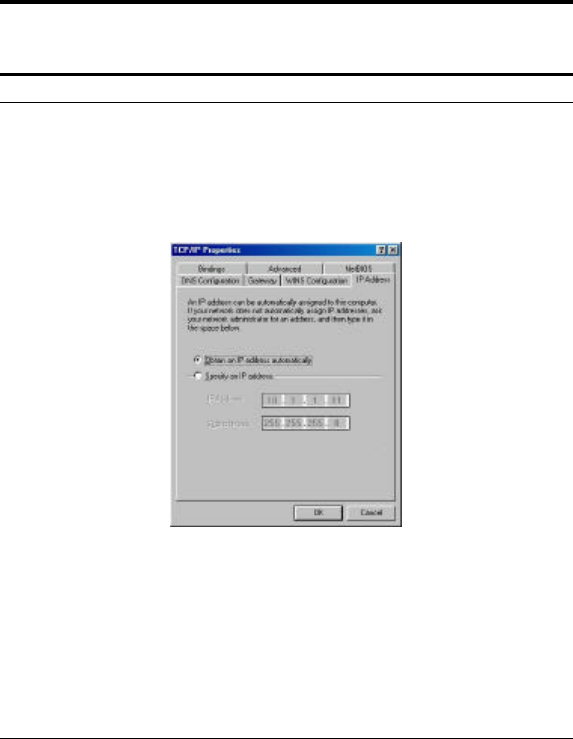
11
PC NETWORK TCP/IP SETTING
The network TCP/IP settings differ based on the computer’s operating
system (Win95/98/ME/NT/2000/XP) and are as follows .
Windows 95/98/ME
1. Click on the “Network neighborhood” icon found on the desktop.
2. Click the right mouse button and a context menu will be show.
3. Select “Properties” to enter the TCP/IP setting screen.
4. Select “Obtain an IP address automatically” on the “IP address”
field.
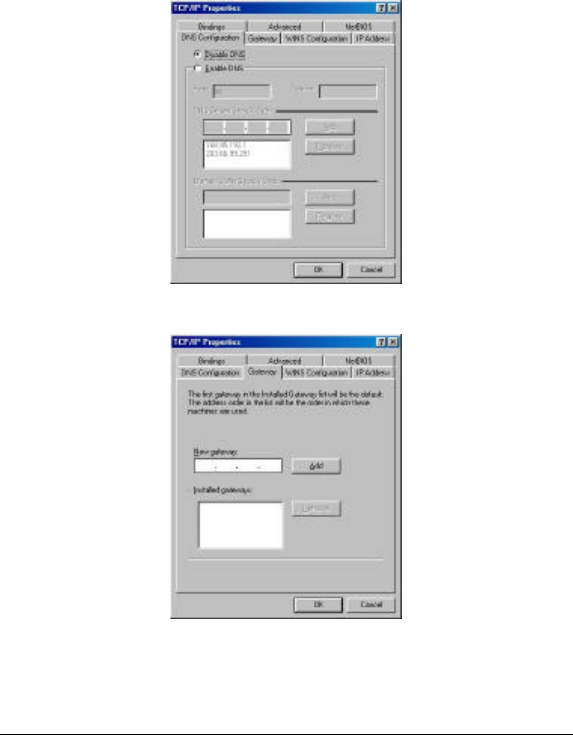
12
5. Select “Disable DNS” in the “DNS” field.
6. Select “None” for the “Gateway address” field.
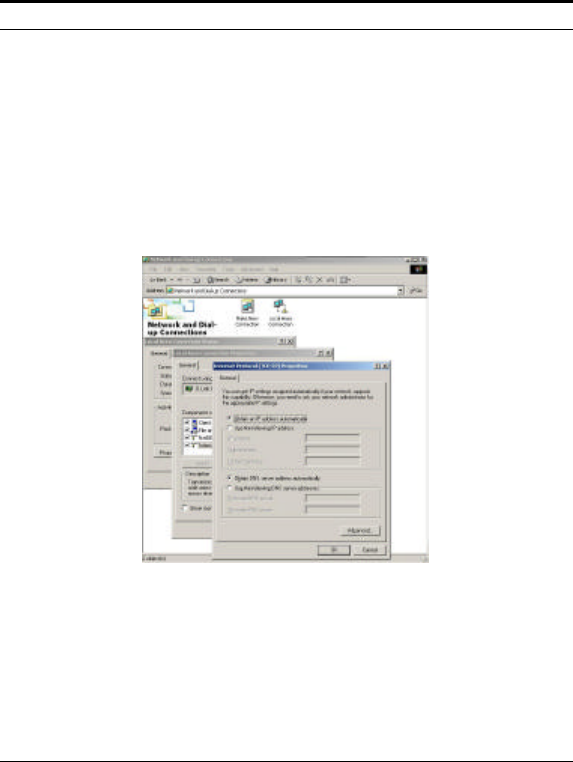
13
Windows 2000
Double click on the “My computer” icon on the desktop. When “My
computer” window opens, open the “Control panel” and then open the
“Network dialup connection” applet. Double click on the “Local area
network connection” icon. Select “Properties” to enter the TCP/IP setting
window.
1. In the “Local area network status” window, click on “Properties.”
2. In the “Local area network connection” window, first select
TCP/IP setting and then select “Properties.”
3. Set both “IP address” and “DNS” to Automatic configuration.
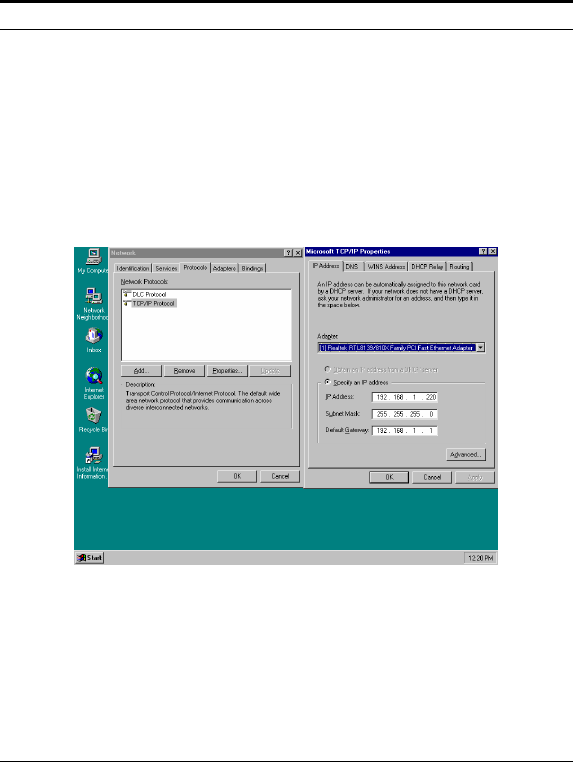
14
Windows NT4.0
Click on the “Start” button located on the lower left corner of the menu
bar.
Select “Settings” and then “Control panel.”
In the “Control panel” window, select “Network” to enter the TCP/IP
setting window.
1. Set “IP address” to “Obtain an IP address automatically.”
2. Set “DNS” to “Disable DNS.”
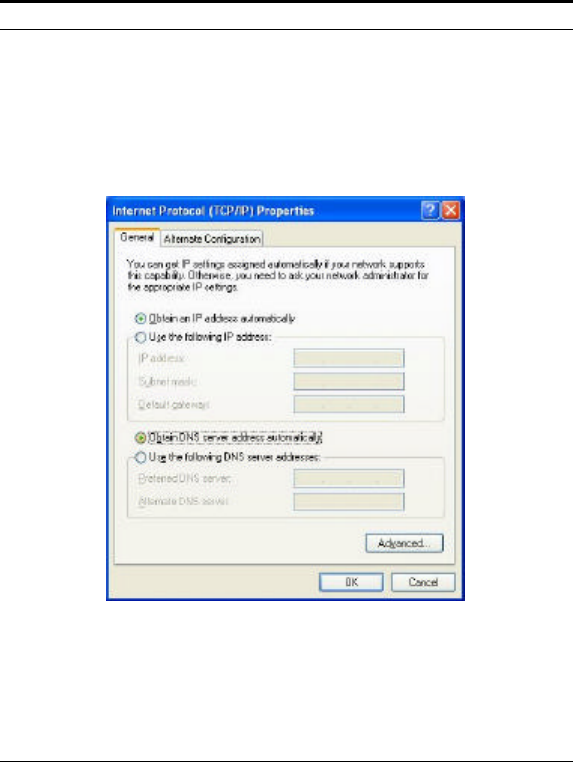
15
Windows XP
Point the cursor and click the right button on the “My Network Place”
icon.
Select “properties ” to enter the TCP/IP setting window.
1. Set “IP address” to “Obtain an IP address automatically.”
2. Set “DNS” to “Obtain DNS server address automatically.”
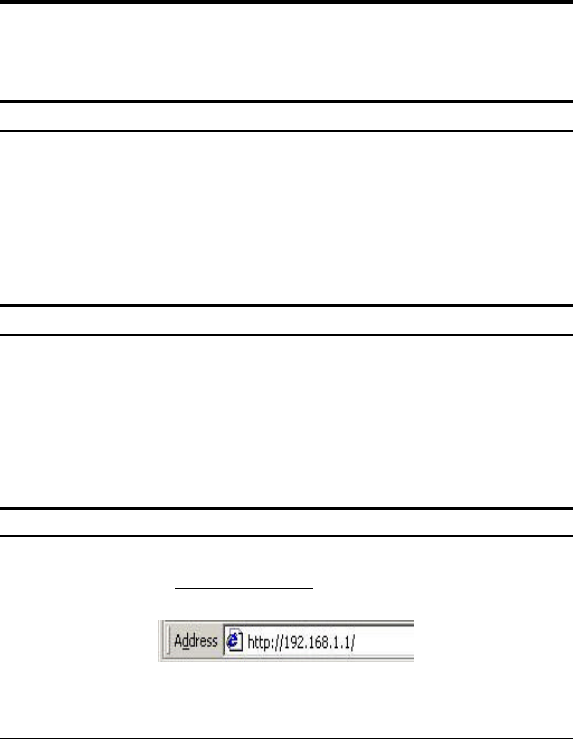
17
WIRELESS BROADBAND ROUTER CONFIGURATION
First make sure that the network connections are functioning normally.
This Wireless Broadband Router can be configured using Internet
Explorer 4.0 or newer web browser versions.
Login to the Wireless Broadband Router through WLAN
Before configuring the Wireless Broadband Router through WLAN, make
sure that the SSID, Channel and the WEP is set properly.
The default setting of the Wireless Broadband Router that you will use:
SSID: default
Channel: 6
WEP Encryption: disable
Login to the Wireless Broadband Router through LA N
Before you configure this device, note that when the Wireless Broadband
Router is configured through an Ethernet connection, make sure the host
PC must be set on the IP subnetwork that can be accessed by the
xDSL/Cable modem. For example, when the default network address of
the xDSL/Cable modem Ethernet interface is 192.168.1.x, then the host
PC should be set at 192.168.1.xxx (where xxx is a number between 2 and
254), and the default subnet mask is 255.255.255.0.
Using the Web Browser
1. Open Internet Explorer 4.0 or above Internet browser.
2. Enter IP address http://192.168.1.1 (the factory-default IP address
setting) to the URL web address location.
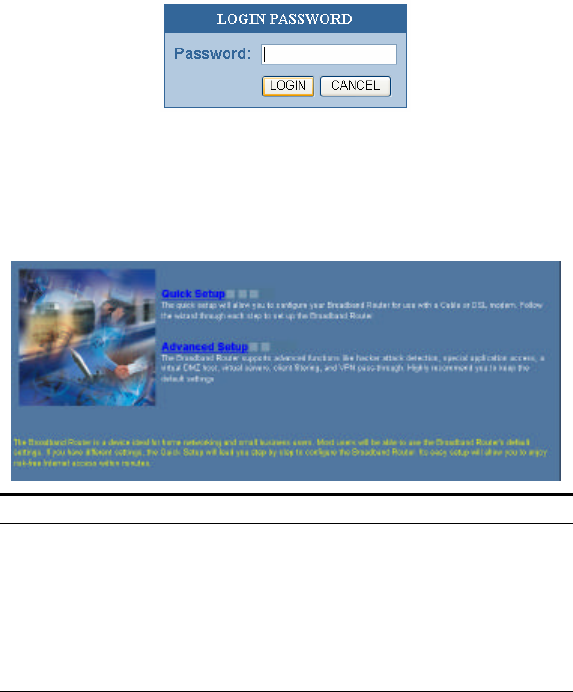
18
3. When the following dialog box appears, remain blank (first login) or
enter the password and press Login to enter the main configuration
window.
Note: If needed to set a password, then refer to the Administrator
Setting.
4. After entering the password, the main web page comes up, there are
two choices for setting, Quick Setup or A dvanced Setup, it is
recommended that the beginner to use the Quick Setup, it will lead
you step by step to configure the Broadband Router.
Quick Setup
In the main web page, select “Quick Setup” to specify the Time Zone,
Wireless Settings and the WAN connection type: Cable modem (DHCP),
Fixed IP, or Dial-up xDSL (PPPoE).
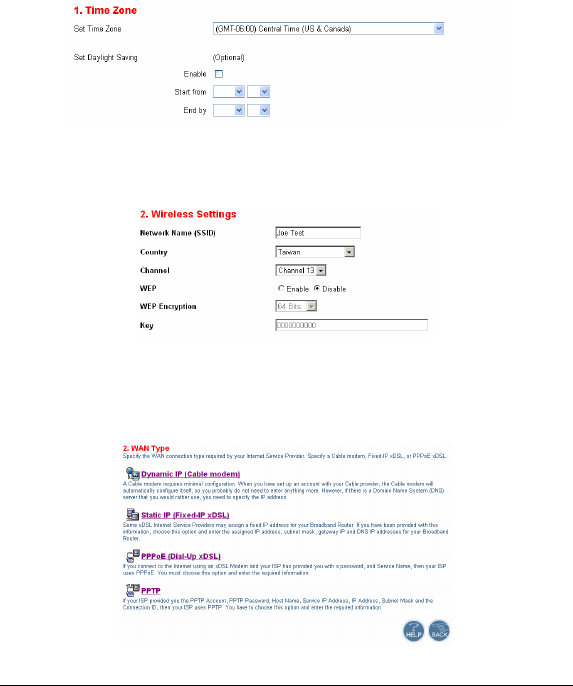
19
1-1 Time Zone
To set the time zone in order to synchronize the system clock in the global
through the SNTP Server.
1-2 Wireless Settings
To set the SSID, Country (Domain Regulatory), Channel, and WEP
Settings of the Wireless Broadband Router.
1-3 WAN Connection Type
To select which the WAN connection type will be connected to, point the
cursor to the Cable modem (DHCP), Fixed IP, or Dial-up xDSL (PPPoE)
to process.
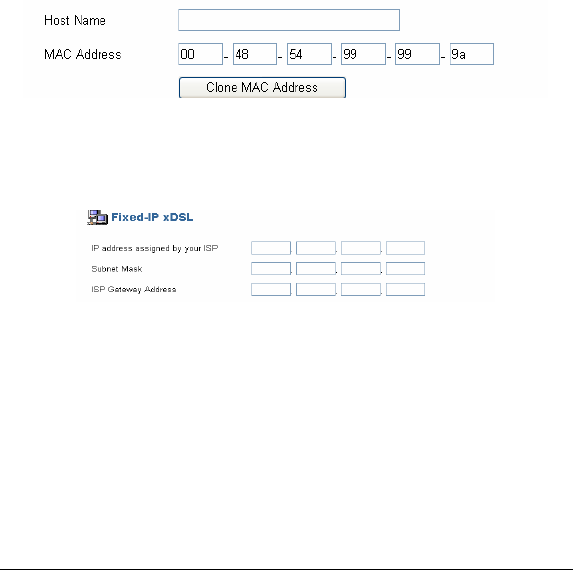
20
1-3-1 Dynamic IP (Cable modem)
To connect a cable modem with the Broadband Router, check the cable
modem with the related user’s guide, then the Cable modem will
automatically configure itself, the Broadband Router is configured to
automatically assign addresses to each PC.
Fill up the MAC Address of the network adapter when the DNS server
need a certain address with the network adapter, or press the “Clone MAC
Address” button to get the manager’s PC MAC Address.
1-3-2 Fixed IP
If the Internet Service Providers assign a fixed IP address, choose this
option and enter the assigned IP address, subnet mask, gateway IP and
DNS IP addresses for your Broadband Router.
1-3-3 PPPoE (Dial-up xDSL)
If connected to the Internet using a PPPoE (Dial-up xDSL) Modem, the
ISP will provide a Password and User Name, then the ISP uses PPPoE.
Choose this option and enter the required information, if the ISP provided
a Service Name, enter it in the column of the Service Name field,
otherwise, leave it blank.
The dialog box in Service Name, IP Address and DNS Address must be
filled up when the ISP Provider provide these information to you, if the
ISP Provider provides Dynamic IP Address, then you can skip on these
dialog box.
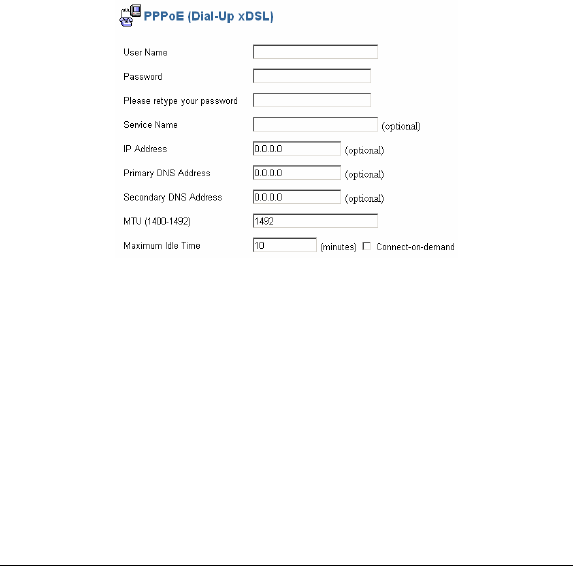
21
The MTU feature specifies the largest packet size permitted for network
transmission. Enter the value desired, for most DSL users, it is
recommended to use 1492. By default, MTU is set at 1492.
The Maximum Idle Time feature can control the connection time while
user’s need to save the cost of connection fee from ISP provider (default
time=0, always connect). Click on the Connect-on-demand button to dial
up to the ISP when only on demand, while there is a need of connecting to
the ISP automatically.
1-3-4 PPTP
If connected to the Internet using a (PPTP) xDSL Modem, enter the PPTP
Account Name, PPTP Password, Host Name, Service IP Address, Your IP
Address, Your Subnet Mask required by your ISP in the appropriate fields.
If your ISP has provided you with a Connection ID, enter it in the
Connection ID field, otherwise, leave it zero.
The MTU feature specifies the largest packet size permitted for network
transmission. Enter the value desired, for most DSL users, it is
recommended to use 1460, by default, MTU is set at 1460.
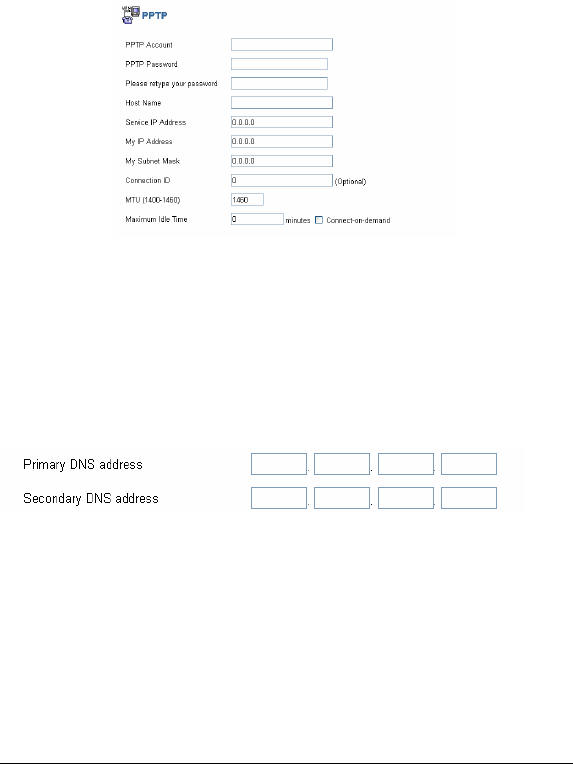
22
The Maximum Idle Time feature can control the connection time while
user’s need to save the cost of connection fee from ISP provider (default
time=0, always connect). Click on the Connect-on-demand button to dial
up to the ISP when only on demand, while there is a need of connecting to
the ISP automatically.
1-4 DNS
The Domain Name System (DNS) is the way that Internet domain names
are located and translated into Internet Protocol (IP) addresses.
If your ISP provided at least one DNS Server IP Address, type that IP
Address in the Primary DNS address fields. You can type up to another
DNS Server IP Addresses. The Router will utilize these for quicker access
to functioning DNS Servers.
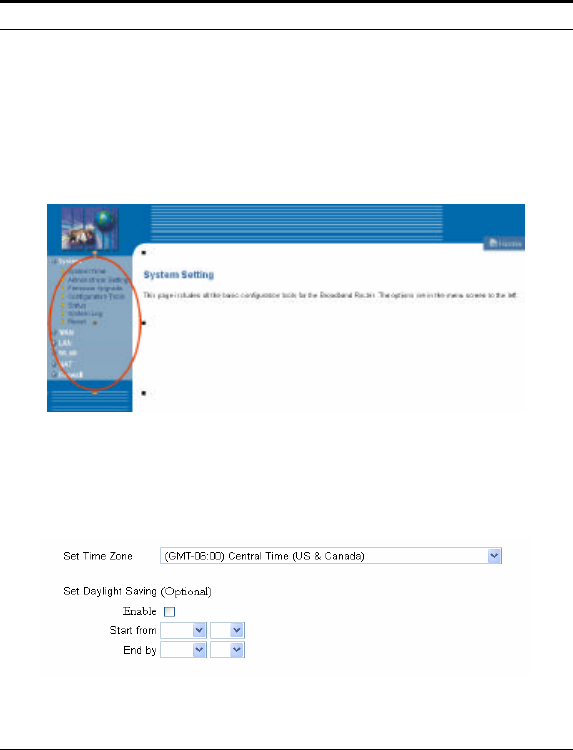
23
Advance Setup
The Broadband Router supports advanced functions like System setting
WAN setting, LAN setting, WLAN setting, NAT Setting and Firewall
setting.
2-1 System
This page includes all the basic configuration tools for the Broadband
Router. Point the selections in the left side of the menu screen.
2-1-1 System Time
Connecting to a Simple Network Time Protocol (SNTP) server allows the
Broadband Router to synchronize the system clock to the global Internet
through the SNTP Server. The synchronized clock in the Broadband
Router is used to record the system log and control client filtering.
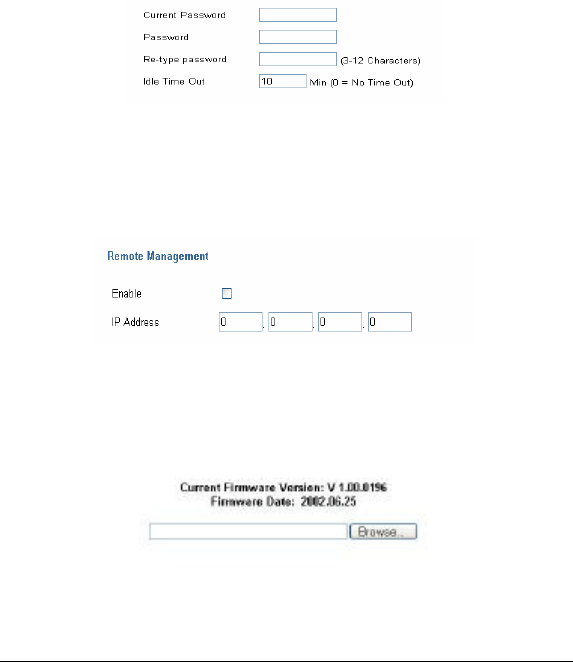
24
2-1-2 Administrator Settings
l Password Settings
Set a password to restrict management access to the Broadband Router.
l Remote Management from Internet
To manage the Broadband Router from a remote location (outside of the
local network through WAN port), it must specify the IP address of the
remote PC, otherwise, leave the IP address 0.0.0.0, means all legal IP
address can access the device.
2-1-3 Firmware Upgrade
By upgrading a new firmware for the Wireless Broadband Router to
improve functionality and performance. Enter the path and name of the
upgrade file then click the APPLY button below. You will be prompted to
confirm the upgrade.
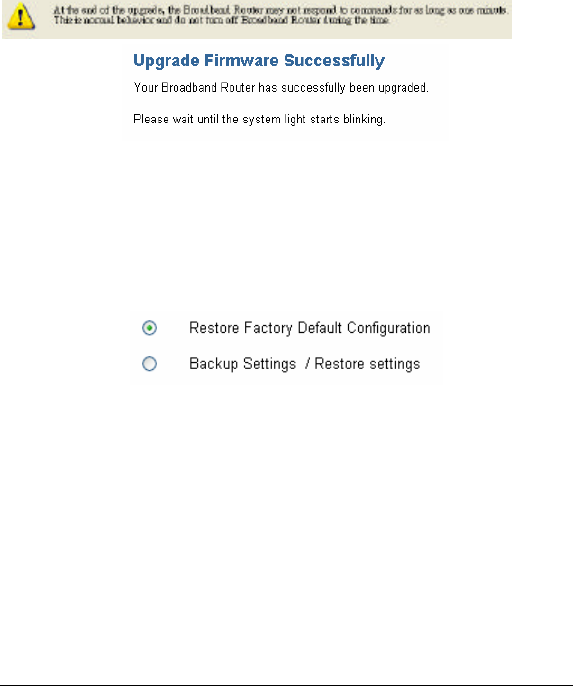
25
While updating the firmware, please wait after pressing the APPLY
button, and follow the instruction on the screen, the System Light on the
front panel will start blinking when the firmware upgraded successfully.
2-1-4 Configuration Tools
Use the "Backup Settings" tool to save the Broadband Router's current
configuration to a file named "config.bin" on your PC. You can then use
the "Restore Settings" tool to restore the saved configuration of the
Broadband Router that you set before. Alternately, you can use the
"Restore to Factory Defaults" tool to force the Broadband Router to
perform reset and restore the original factory settings.
l Restore Factory Default
To restore the factory default settings of the Broadband Router,
click on the “Restore” button.
l Backup Settings
Press the “Backup Settings” button to save the current setting in a
filed “config.bin” or given filename.
l Restore Settings
To restore the backup file to the Broadband Router, enter the path
and filename on the restore settings.
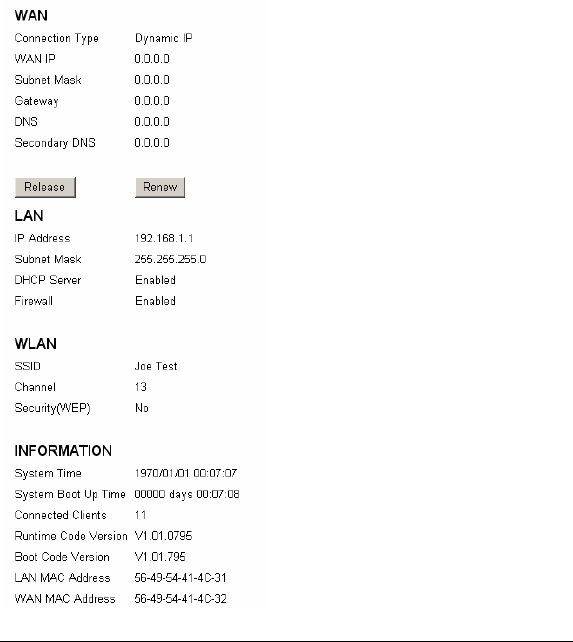
26
2-1-5 Status
Use the Status screen to see the connection status for the Wireless
Broadband Routers' WAN, LAN, WLAN interfaces, firmware and
hardware vers ion numbers, and the number of connected clients to the
network.
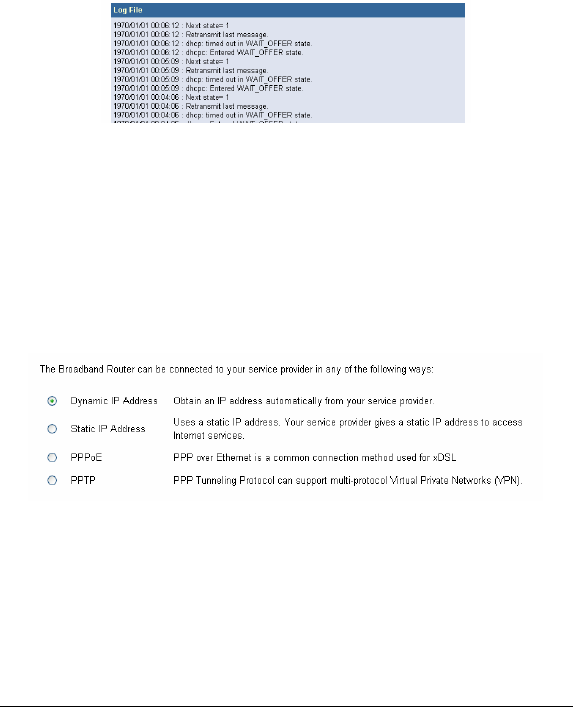
27
2-1-6 System Log
View any attempts that have been made to gain access to the network.
2-1-7 Reset
In the event that the Broadband Router stops responding correctly or in
some way stops functioning, perform the reset function. The settings will
not be changed. To perform the reset, click on the "Reset" button. The
reset will be complete when the system light starts blinking.
2-2 WAN
The Broadband Router can be connected to the service provider in any of
the following ways: Dynamic IP Address, Static IP Address, PPPoE and
PPTP.
2-2-1 Dynamic IP
The Host Name is optional, but may be required by some Service
Providers. The default MAC address is set to the WAN's physical
interface on the Broadband Router. If the Service Provider requires the
host name, using the "Clone MAC Address" button to copy the MAC
address of the Network Interface Card installed in the selected PC and
replaces the WAN MAC address with this MAC address.
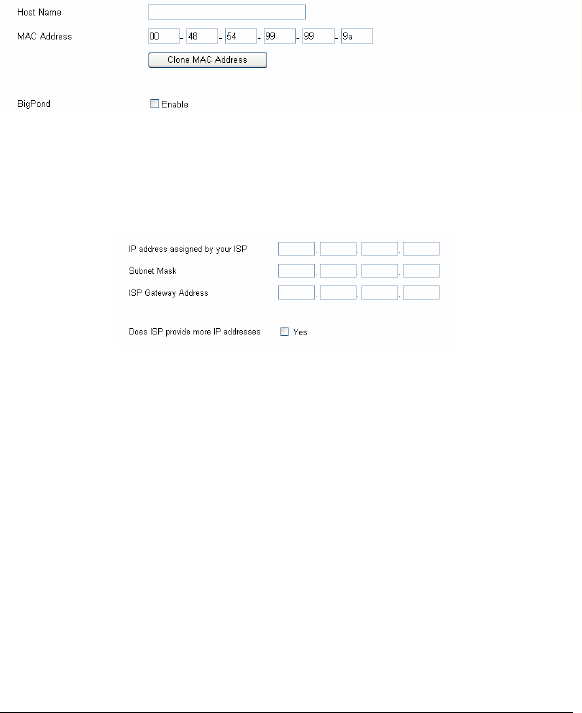
28
The road runner management is optional. If the ISP needs to run the road
runner management (sometimes called Big Pond), enable it.
2-2-2 Static IP
If the Service Provider has assigned a fixed IP address, enter the assigned
IP address subnet mask and gateway address provided. Click “yes ” if
using two or more IP addresses.
2-2-3 Dial-up xDSL (PPPoE)
If connected to the Internet using a Dial-up xDSL (PPPoE) Modem, the
ISP will provide a Password and User Name, and then the ISP uses
PPPoE. Choose this option and enter the required information, if the ISP
provided a Service Name, enter it in the column of the Service Name field,
otherwise, leave it blank.
The dialog box in Service Name, IP Address and DNS Address must be
filled up when the ISP Provider provide these information to you, if the
ISP Provider provides Dynamic IP Address, then you can skip on these
dialog box.
The MTU feature specifies the largest packet size permitted for network
transmission. Enter the value desired, for most DSL users, it is
recommended to use 1492. By default, MTU is set at 1492.
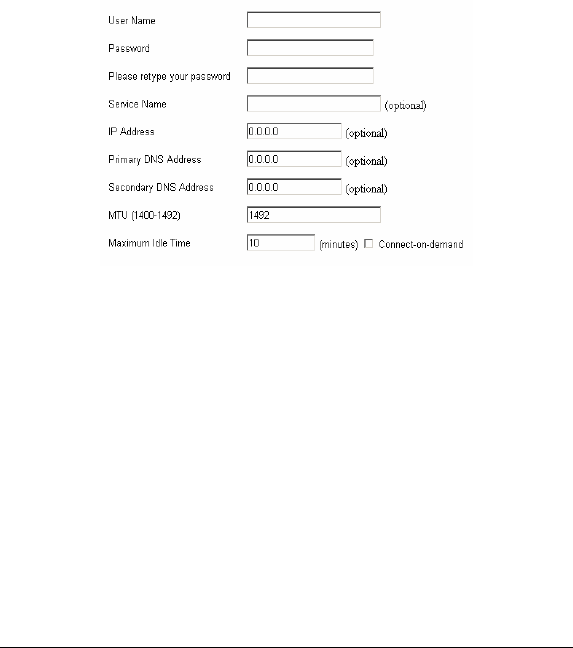
29
The Maximum Idle Time feature can control the connection time while
user’s need to save the cost of connection fee from ISP provider (default
time=0, always connect). Click on the Connect-on-demand button to dial
up to the ISP when only on demand, while there is a need of connecting to
the ISP automatically.
2-2-4 PPTP
If connected to the Internet using a (PPTP) xDSL Modem, enter the PPTP
Account Name, PPTP Password, Host Name, Service IP Address, Your IP
Address, Your Subnet Mask required by your ISP in the appropriate fields.
If your ISP has provided you with a Connection ID, enter it in the
Connection ID field, otherwise, leave it zero.
The MTU feature specifies the largest packet size permitted for network
transmission. Enter the value desired, for most DSL users, it is
recommended to use 1460. By default, MTU is set at 1460
The Maximum Idle Time feature can control the connection time while
user’s need to save the cost of connection fee from ISP provider (default
time=0, always connect). Click on the Connect-on-demand button to dial
up to the ISP when only on demand, while there is a need of connecting to
the ISP automatically.
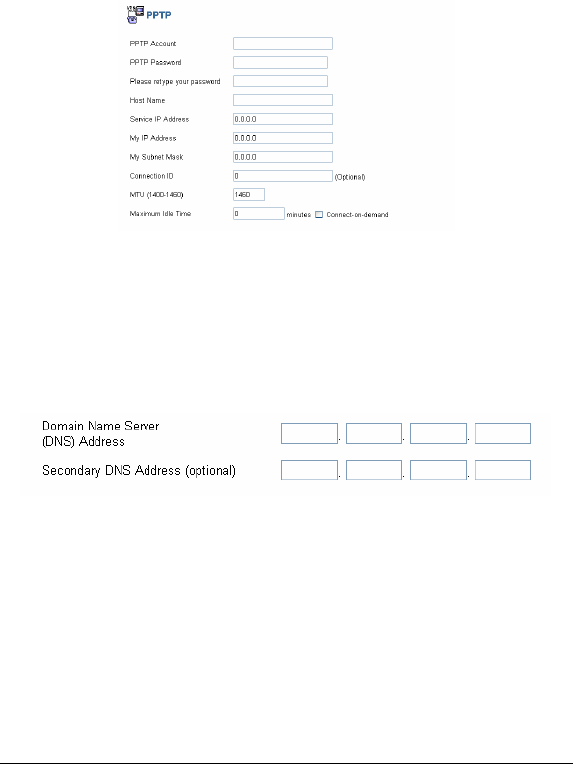
30
2-2-5 DNS
The Domain Name System (DNS) is the way that Internet domain names
are located and translated into Internet Protocol (IP) addresses.
If your ISP provided at least one DNS Server IP Address, type that IP
Address in the Primary DNS address fields. You can type up to another
DNS Server IP Addresses. The Router will utilize these for quicker access
to functioning DNS Servers.
2-3 LAN
Setting the LAN’s IP Address and DHCP Service.
2-3-1 LAN Settings
The default value is 192.168.1.1 for the IP address and 255.255.255.0 for
the Subnet Mask. And you can also change the value for your needs.
To enable the DHCP serv er for dynamic IP address allocation to the
clients PCs, click the “Enable”. The client can get the IP Addresses from a
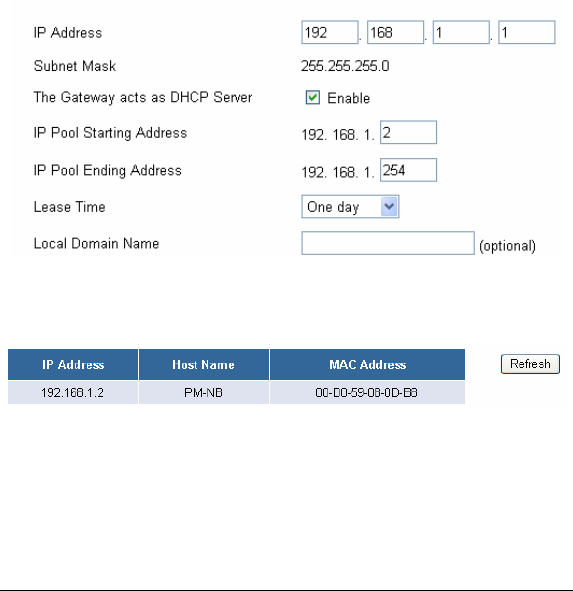
31
range from IP Pool Starting Address to IP Pool Ending Address; also, you
can change the IP Pool range value.
The Lease Time is the amount of time a network user will be allowed
connection to the Router with their current dynamic IP address. Enter the
amount of time, in hours , days or weeks, which the user will be “leased”
this dynamic IP address.
You can enter your local domain name in the Local Domain Name fields.
2-3-2 DHCP Client List
The DHCP client list allows you to see which clients are connected to the
Barricade via IP address, host name, and MAC address.
2-4 WLAN
To set the WLAN’s SSID, Regulatory Do main, Channel and WEP
Encryption.
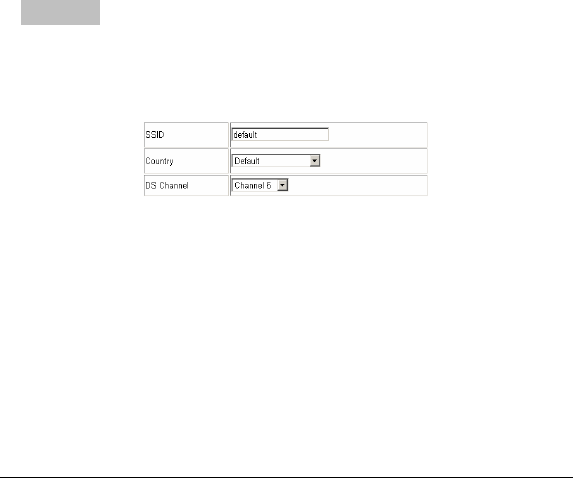
32
2-4-1 WLAN Setting
Ø SSID: The SSID differentiates one WLAN group name from
another; so all access points and all devices attempting to connect to
a specific WLAN group name must use the same SSID. A device
will not be permitted to join the BSS unless it can provide the unique
SSID.
Ø Country: this is the channel selection of each country regulatory
domain, select the country where you are using this Wireless
Broadband Router, users are responsible for ensuring that the
channel set configuration is in compliance with the regulatory
standards of these countries. The default setting of this Wireless
Broadband Router is following the FCC rules using Channel 1~11.
Warning: Be noted that selecting the incorrect region may result
in a violation of applicable law; you will need to select the correct
domain.
Ø DS Channel: It shows radio channel numbers that used for
WLAN networking.
WEP Key Setting
While enabling the WEP Key Setting, the security of the Wireless
Broadband Router will be activated, it will prevent unauthorized
access to a wireless network.
Ø WEP Key Type: selection of WEP key format using HEX type
(hexadecimal 0~F) or ASCII type (alphanumeric 0~9, A~Z and a~z).
Ø 64 bit Encryption: when you select 64 bit encryption using HEX
mode, you must type 10 values in the following range (0~F,
hexadecimal) in key 1 to key 4, or 64bit in ASCII format, you must
type 5 values in the following range (0~9, A~Z and a~z
Alphanumeric ).
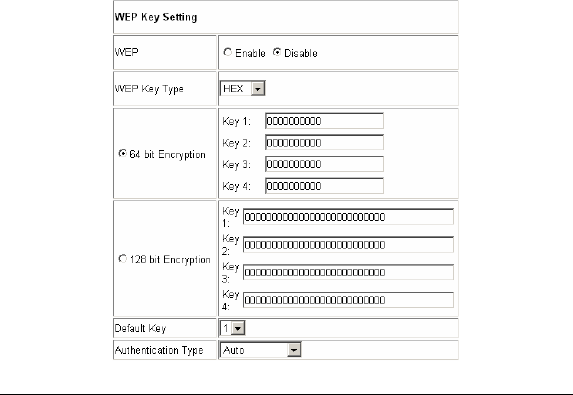
33
Ø 128 bit Encryption: when you select 128 bit encryption, you
must type 26 values in the following range (0~F, hexadecimal) in
key 1 to key 4, or 128bit in ASCII format, you must type 13 values
in the following range (0~9, A~Z and a~z Alphanumeric).
Ø Default Key: select the default key that you want to use in this
Wireless Broadband Router.
Ø Authentication Type:
Open System: with the same WEP key between the stations, the
stations don’t need to be authenticated, and this algorithm is mostly
used.
Shared Key: with the same WEP key between the stations in this
Authentication algorithm, this type will use packets with encryption
by transferring a challenge text which will be acknowledge by both
side of the stations.
Auto: by selecting this auto mode, the system will automatically
select which authentication type is suitable for the WLAN networking.
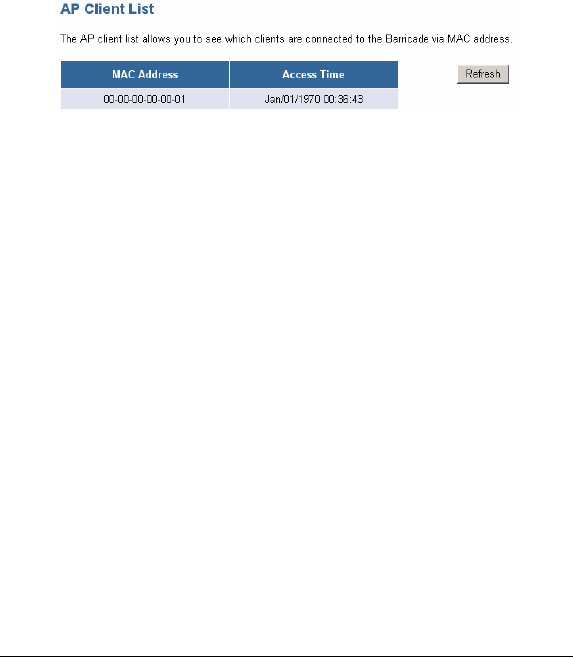
34
2-4-2 AP Client List
The AP client list allows you to see which clients are connected to this
Wireless Broadband Router via MAC address.
Use “Refresh” button to display the new list of the connected clients
2-5 NAT
Network Address Translation (NAT) allows multiple users at the local site
to access the Internet through a single public IP address. NAT can also
prevent hacker attacks by mapping local addresses to public addresses for
key services such as the Web or FTP.
2-5-1 Special Application
Some applications require multiple connections, such as Internet gaming,
video conferencing, Internet telephony and others. These applications
cannot work when Network Address Translation (NAT) is enabled. When
users send this type of request to your network via the Internet, the Router
will forward those requests to the appropriate PC. If you need to run
applications that require multiple connections, specify the port normally
associated with an application in the "Trigger Port" field, select the
protocol type as TCP or UDP, then enter the public ports associated with
the trigger port to open them for inbound traffic.
l TCP (Transmission Control Protocol) - A method (protocol) used
along with the Internet Protocol (Internet Protocol) to send data in
the form of message units between computers over the Internet.
While IP takes care of handling the actual delivery of the data, TCP
takes care of keeping track of the individual units of data (called
packets) that a message is divided into for efficient routing through
the Internet.
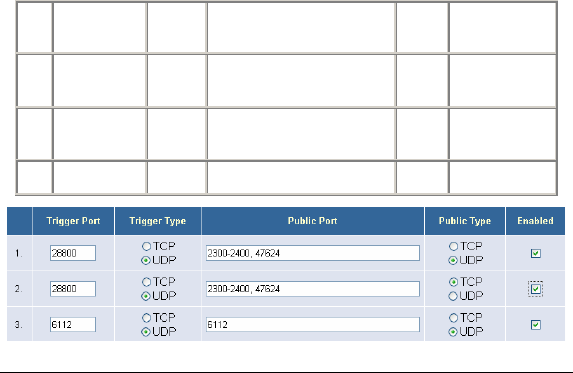
35
l UDP (User Datagram Protocol) - A communications method
(protocol) that offers a limited amount of service when messages
are exchanged between computers in a network that uses the
Internet Protocol (IP). UDP is an alternative to the TCP and,
together with IP, is sometimes referred to as UDP/IP. Like the
Transmission Control Protocol, UDP uses the Internet Protocol to
actually get a data unit (called a datagram) from one computer to
another. Unlike TCP, however, UDP does not provide the service of
dividing a message into packets (datagrams) and reassembling it at
the other end. Specifically, UDP doesn't provide sequencing of the
packets that the data arrives in. This means that the application
program that uses UDP must be able to make sure that the entire
message has arrived and is in the right order. Network applications
that want to save processing time because they have very small data
units to exchange (and therefore very little message reassembling to
do) may prefer UDP to TCP.
Example:
ID
Trigger Port
Trigger
Type
Public Port Public
Type
Comment
1
28800 UDP
2300-2400, 47624 UDP
MSN Game
Zone
2
28800 UDP
2300-2400, 47624 TCP
MSN Game
Zone
3
6112 UDP
6112 UDP
Battle.net
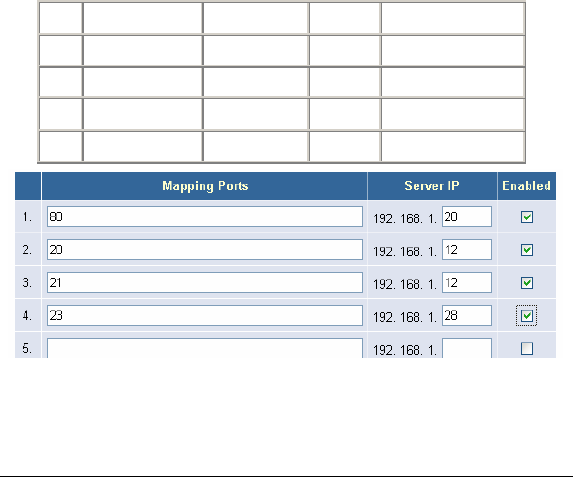
36
2-5-2 Virtual Server
Configure the Broadband Router as a virtual server to allow the Router to
watch outgoing data for specific port numbers. The IP address of the
computer that sends the matching data is remembered by the Router, so
that when the requested data returns through the Router, the data is pulled
back to the proper computer by way of IP address and port mapping rules
such as the Web or FTP at the local site via public IP addresses can be
automatically redirected to local servers configured with private IP
addresses. In other words, depending on the requested service (TCP/UDP
port number), the Broadband Router redirects the external service request
to the appropriate server.
Example:
ID
Server IP Mapping Port
Type Comment
1 192.168.2.20 80 TCP Web Server
2 192.168.2.12 20 TCP FTP Server
3 192.168.2.12 21 TCP FTP Server
4 192.168.2.28 23 TCP Telnet Server
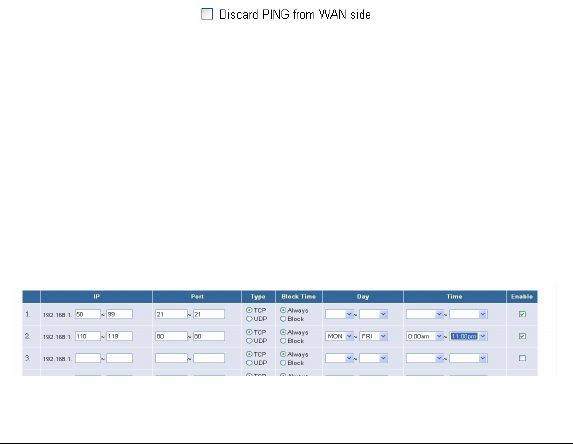
37
2-6 Firewall
The Broadband Router provides extensive firewall protection by
restricting connection parameters to limit the risk of hacker attack, and
defending against a wide array of common hacker attacks.
The Broadband Router provides packet filtering rules by restricting
service ports, IP address or MAC address. However, for applications that
require unrestricted access to the Internet, configure a specific
client/server as a demilitarized zone (DMZ).
2-6-1 Block WAN Ping
When the "Block WAN Ping" activated, it is causing the public WAN IP
address on the Broadband Router not to respond to ping commands.
Pinging public WAN IP addresses is a common method used by hackers
to test whether the WAN IP address is valid and supports a network.
2-6-2 Client Filtering
To block a certain client PCs accessing the Internet based on time.
You can filter Internet access for local clients based on IP addresses,
application types, (i.e., HTTP port), and time of day.
For example, this screen shows that clients in the address range
192.168.2.50-99 are permanently restricted from using FTP (Port 21),
while clients in the address range 192.168.2.110-119 are blocked from
browsing the Internet (port 80) from Monday to Friday and from 0:00AM
to 11:00 PM.
Example:
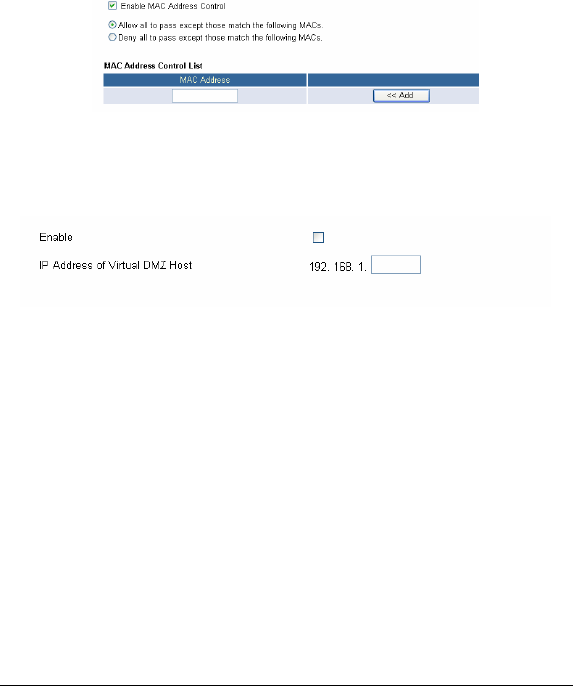
38
2-6-3 MAC Control
You can block certain client PCs accessing the Internet based on MAC
addresses.
2-6-4 DMZ (Demilitarized Zone)
If a local client PC cannot run an Internet application properly from
behind the NAT firewall, open the client up to unrestricted two-way
Internet access by defining a virtual DMZ Host.

39
TECHNICAL SPECIFICATIONS
General
Standards IEEE 802.3u 100BASE-TX Fast Ethernet
IEEE 802.11b
Protocol CSMA/CD
Radio
Technology IEEE 802.11b Direct Sequence Spread Spectrum (DSSS)
Data Transfer
Rate WLAN: 1, 2, 5.5, 11Mbps (auto sense)
Ethernet: 10Mbps (half duplex), 20Mbps (full-duplex)
Fast Ethernet: 100Mbps (half duplex), 200Mbps (full- duplex)
Topology Star
Receiver
Sensitivity
11Mbps: Typical –83dBm @ 8% PER (Packet Error Rate)
2Mbps: Typical –84dBm @ 8% PER (Packet Error Rate)
Network
Cables 10BASE-T: 2-pair UTP Cat. 3,4,5 (100 m), EIA/TIA- 568 100-
ohm STP (100 m)
100BASE-TX: 2-pair UTP Cat. 5 (100 m), EIA/TIA-568 100-
ohm STP (100 m)
Frequency
Range 2400 ~ 2497 MHz ISM band (channels 1 ~ 14)
Modulation
Schemes DBPSK/DQPSK/CCK
Security 64/128-bits WEP Encryption
Channels 1 ~ 11 channels (FCC); 1 ~ 13 channels (ETSI);
1 ~ 14 channels (Japan)
Number of
Ports LAN: 4 x 10/100Mbps Auto-MDIX Fast Ethernet port
WAN: 1 x 10/100Mbps Auto-MDIX Fast Ethernet port
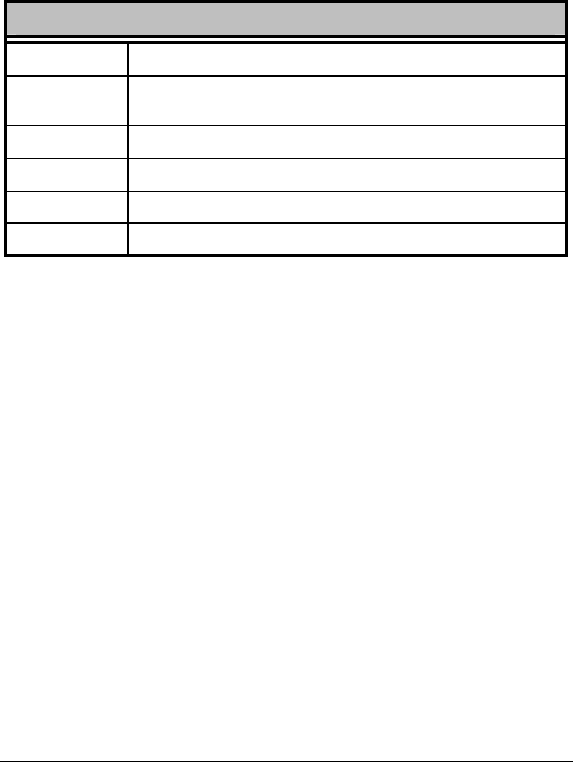
40
Physical and Environmental
DC inputs DC 7.5V 1A
Power
Consumption 3W (Max)
Temperature Operating: 0° ~ 40° C, Storage: -10° ~ 70° C
Humidity Operating: 10% ~ 90%, Storage: 5% ~ 90%
Dimensions 171 x 100 x 34 mm (W x H x D) without Antenna
EMI: FCC Class B, CE Mark B